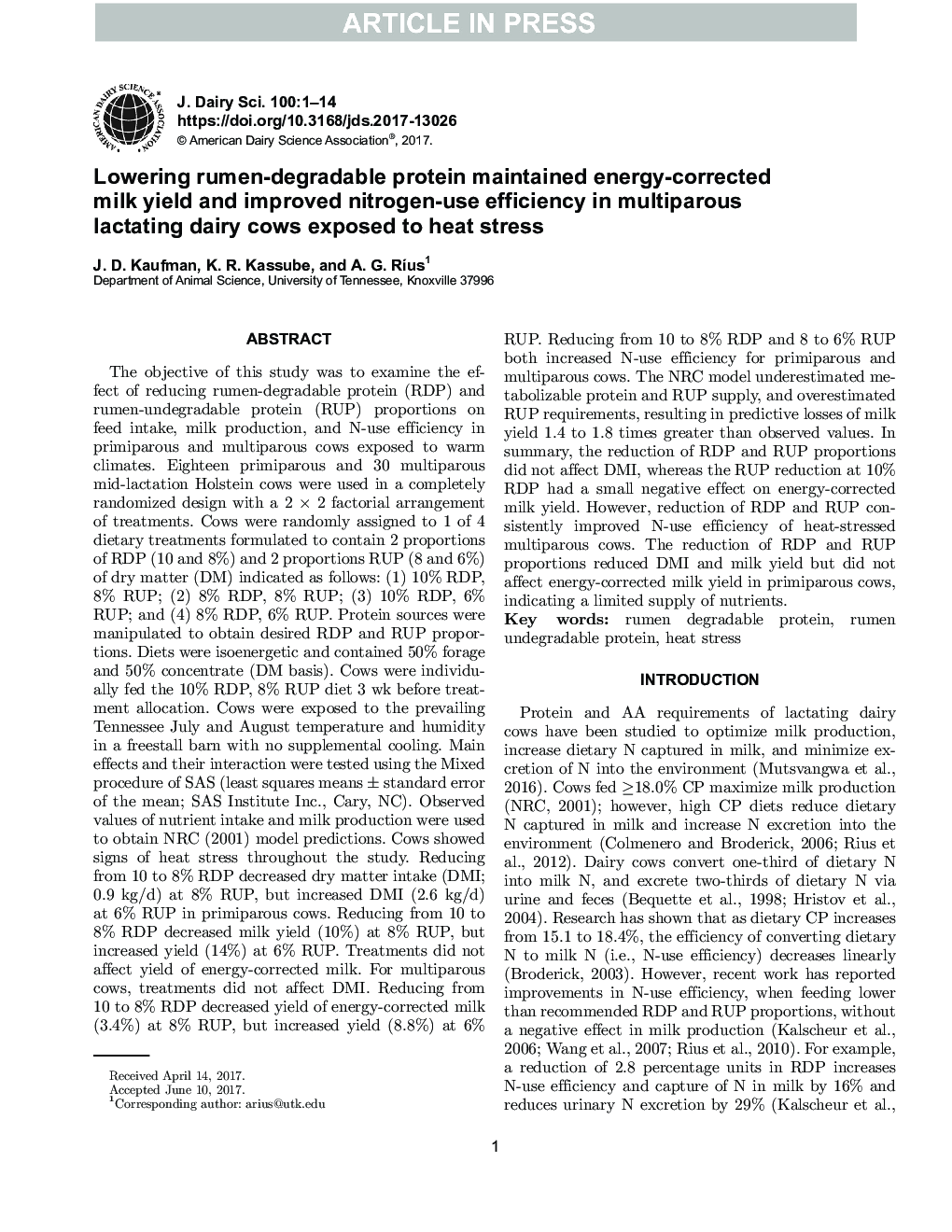| کد مقاله | کد نشریه | سال انتشار | مقاله انگلیسی | نسخه تمام متن |
|---|---|---|---|---|
| 5541999 | 1402513 | 2017 | 14 صفحه PDF | دانلود رایگان |
عنوان انگلیسی مقاله ISI
Lowering rumen-degradable protein maintained energy-corrected milk yield and improved nitrogen-use efficiency in multiparous lactating dairy cows exposed to heat stress
ترجمه فارسی عنوان
کاهش پروتئین قابل تجزیه شکمبه حفظ تولید شکر اصلاح شده با انرژی و بهبود کارآیی نیتروژن در گاو های شیری شیرده چندگانه در معرض استرس گرما
دانلود مقاله + سفارش ترجمه
دانلود مقاله ISI انگلیسی
رایگان برای ایرانیان
کلمات کلیدی
پروتئین قابل تجزیه، پروتئین غیرقابل برگشت شکم، استرس گرما،
موضوعات مرتبط
علوم زیستی و بیوفناوری
علوم کشاورزی و بیولوژیک
علوم دامی و جانورشناسی
چکیده انگلیسی
The objective of this study was to examine the effect of reducing rumen-degradable protein (RDP) and rumen-undegradable protein (RUP) proportions on feed intake, milk production, and N-use efficiency in primiparous and multiparous cows exposed to warm climates. Eighteen primiparous and 30 multiparous mid-lactation Holstein cows were used in a completely randomized design with a 2 à 2 factorial arrangement of treatments. Cows were randomly assigned to 1 of 4 dietary treatments formulated to contain 2 proportions of RDP (10 and 8%) and 2 proportions RUP (8 and 6%) of dry matter (DM) indicated as follows: (1) 10% RDP, 8% RUP; (2) 8% RDP, 8% RUP; (3) 10% RDP, 6% RUP; and (4) 8% RDP, 6% RUP. Protein sources were manipulated to obtain desired RDP and RUP proportions. Diets were isoenergetic and contained 50% forage and 50% concentrate (DM basis). Cows were individually fed the 10% RDP, 8% RUP diet 3 wk before treatment allocation. Cows were exposed to the prevailing Tennessee July and August temperature and humidity in a freestall barn with no supplemental cooling. Main effects and their interaction were tested using the Mixed procedure of SAS (least squares means ± standard error of the mean; SAS Institute Inc., Cary, NC). Observed values of nutrient intake and milk production were used to obtain NRC (2001) model predictions. Cows showed signs of heat stress throughout the study. Reducing from 10 to 8% RDP decreased dry matter intake (DMI; 0.9 kg/d) at 8% RUP, but increased DMI (2.6 kg/d) at 6% RUP in primiparous cows. Reducing from 10 to 8% RDP decreased milk yield (10%) at 8% RUP, but increased yield (14%) at 6% RUP. Treatments did not affect yield of energy-corrected milk. For multiparous cows, treatments did not affect DMI. Reducing from 10 to 8% RDP decreased yield of energy-corrected milk (3.4%) at 8% RUP, but increased yield (8.8%) at 6% RUP. Reducing from 10 to 8% RDP and 8 to 6% RUP both increased N-use efficiency for primiparous and multiparous cows. The NRC model underestimated metabolizable protein and RUP supply, and overestimated RUP requirements, resulting in predictive losses of milk yield 1.4 to 5.8 times greater than observed values. In summary, the reduction of RDP and RUP proportions did not affect DMI, whereas the RUP reduction at 10% RDP had a small negative effect on energy-corrected milk yield. However, reduction of RDP and RUP consistently improved N-use efficiency of heat-stressed multiparous cows. The reduction of RDP and RUP proportions reduced DMI and milk yield but did not affect energy-corrected milk yield in primiparous cows, indicating a limited supply of nutrients.
ناشر
Database: Elsevier - ScienceDirect (ساینس دایرکت)
Journal: Journal of Dairy Science - Volume 100, Issue 10, October 2017, Pages 8132-8145
Journal: Journal of Dairy Science - Volume 100, Issue 10, October 2017, Pages 8132-8145
نویسندگان
J.D. Kaufman, K.R. Kassube, A.G. RÃus,
